
Circuit Diagram
Index 145
Isolated Voltage Sensors for Monitoring Power Supply
Published:2013/3/18 21:13:00 Author:Ecco | Keyword: Isolated Voltage Sensors, Monitoring Power Supply
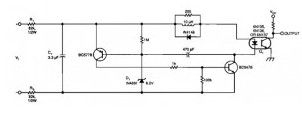
This is simple VCO ( voltage controlled oscillator) circuit , connected to your current instrumentation by an optoisolator, means that you can measure high voltages of your instrumentation more secure. The component values suit a 0 to 600 V input range (power dissipation in R1 and R2 set a limit on the input-voltage range). The circuit’s linearity is not an issue, because you can linearize its output in software.
The input voltage (VI), charges capacitor C1 until zener diode D1 conducts. Then, the zener diode triggers an “avalanche” circuit that discharges C1 into optocoupler Q1. After Cl discharges, the charging cycle repeats. C1 also averages the sensed-voltage level, which thereby provides noise immunity.
(View)
View full Circuit Diagram | Comments | Reading(800)
Simple LCD Power Supply
Published:2013/3/18 21:12:00 Author:Ecco | Keyword: LCD Power Supply
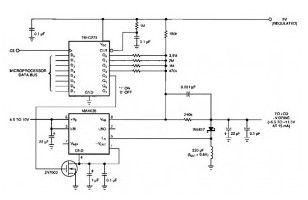
Laptop display commonly apply large screen Lcds, which generally will need a adjustable and a negative supply to ensure highest possible contrast. This circuit works with the system’s positive notebook battery supply and generates a digitally adjustable negative voltage to drive the large screen Lcd notebooks..
The following figure’s switching regulator generates a negative voltage by the notebook battery supply. The microprocessor data bus drives a 4-bit DAC( 74HC273 ), which in turn can vary the regulator output between 6.5 to 11.5 V. This arrangement enables a staircase of 16 possible voltages between these limits. The LCD power supply circuit implements the DAC by using the rail-to-rail output-drive capability of a 74 HC-series CMOS gate. A resistor divider network made by the 240-kO resistor, connected to the V filter capacitor as well as the resistors, is referenced to the 5 V supply control (the MAX635 regulator).
When the voltage at the VFB pin is greater than ground, the switching regulator turns on. The inductor dumps this energy into the – V filter capacitor. When the voltage at VFB is less than ground, the regulator skips a cycle. The MAX635 regulates the voltage at the junction of the resistor divider to 0 V. Thus, any resistor that the DAC connects to ground (logic 0) will not contribute any current to the ladder. Only the resistors that are at 5 V (logic 1) will be part of the voltage-divider equation.
The entire switching-regulator supply draws less than 150 uA. You can place the circuit in an even lower power mode by interrupting the ground pin. The high-current path is from the battery input through the internal power PMOSFET to the external inductor. Disconnecting the ground connection simply disables the gate drive to the FET and turns off the internal oscillator.
(View)
View full Circuit Diagram | Comments | Reading(949)
Switch Mode Voltage Regulator with 85% efficiency
Published:2013/3/18 21:11:00 Author:Ecco | Keyword: Switch Mode, Voltage Regulator, 85% efficiency
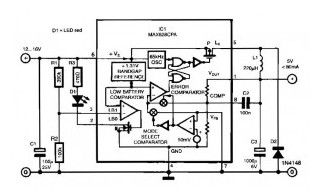
Switch Mode Power Supplies (SMPS) is now widely used in modern electronic equipment due to its compact design and high efficiency of about 80% or more. The switch-mode regulator circuit presented here has an efficiency of around 85%.
The circuit is quite simple thanks to the use of MAX638CPA 5V CMOS Step Down Adjustable Switching Regulator IC. With this IC input voltage of 12 to 16 Vdc converted into direct voltage 5VDC. You can see here is only using 9 additional external components to complete the circuit.
Resistors R1 and R2 are used to indicate when the battery voltage becomes low: as soon as the voltage on pin 3 becomes lower than 1.3 V, D1 lights. With values as shown for the potential divider, this corresponds to the supply voltage getting lower than about 6.5 V. The output of the IC is shunted by a simple LC filter formed by LI, C3 and D2.
The oscillator on board the IC generates a clock frequency of around 65 kHz and drives the output transistor via two NOR gates. The built-in error detector, the “battery low” indicator or the voltage comparator can block the clock frequency, which causes the transistor to switch off.
The MAX638CPA IC compares the output voltage of 5 V with a built-in reference (FET). Depending on the load, the FET will be switched on for longer or shorter periods. The maximum current through the FET is 375 mA, which corresponds with a maximum output current of 80 mA.
(View)
View full Circuit Diagram | Comments | Reading(805)
High Performance Gelled lead acid charger
Published:2013/3/18 21:10:00 Author:Ecco | Keyword: High Performance, Gelled lead , acid charger
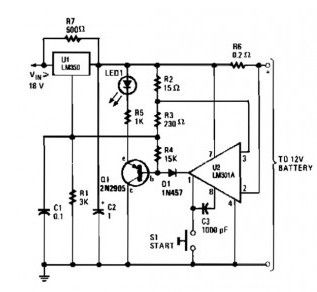
This high performance battery charger circuit allow quickly charges gelled lead-acid batteries, and automatically turns off at full charge. First, the charge current is held at 2 A, but as battery voltage rises, the current will decreases. When current falls to 150 mA, the charger automatically switches to a lower float voltage to keep from overcharging. When you hit full charge, transistor Q1 lights the LED to indicate that status.
(View)
View full Circuit Diagram | Comments | Reading(991)
A simple variable power supply circuit with L200
Published:2013/3/18 21:09:00 Author:Ecco | Keyword: A simple , variable power supply
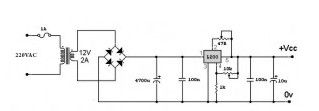
Variable power Supply scheme shown here is very simple, its used regulator IC L200 (ADJUSTABLE VOLTAGE AND CURRENT REGULATOR). L200 is a monolitthic IC for current and voltage programmable regulation. It has current limiting, power limiting, thermal shutdown, and over voltage protection.
Variable power supply based L200 for its output voltage is controlled by a variable resistor 10K. Output voltage range of values is from around 3 to 15 volts, and current range is about 10 mA minimum and a maximum of 2 amps. Exceeding current limit will reduce the output voltage to zero.
(View)
View full Circuit Diagram | Comments | Reading(1810)
Adjustable regulated power supply 3-30 V / 2.5 A
Published:2013/3/18 21:07:00 Author:Ecco | Keyword: Adjustable, regulated power supply , 3-30 V, 2.5 A
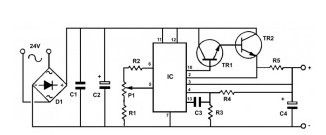
This Adjustable regulated power supply circuit uses voltage regulator LM723 IC which are already well known. IC LM 723 is designed to provide a voltage of 2-37 volt supply voltage with 150mA current, and this current is small indeed, but with the help of an external transistor can be achieved current up to 10 A, and in this circuit can provide voltage 3-30V and is limited to 2.5 A currnt with the help of TR2.
(View)
View full Circuit Diagram | Comments | Reading(1677)
DC power supply 3-30V 3-30V 3A stabilized
Published:2013/3/18 21:06:00 Author:Ecco | Keyword: DC power supply, 3-30V , 3A stabilized
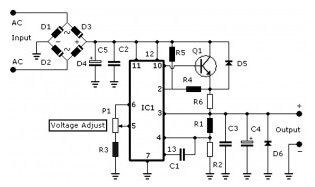
This DC power supply circuit diagram is designed as an additional or as a permanent power supply for all general circuits based on a stable DC voltage between 3 and 30V provided that current consumption does not exceed 3A. Of course, this DC power supply can also be used to other purposes. By replacing the trimmer by a potentiometer, it can even be used as adjustable supply unit. A good quality heatsink must be used.
(View)
View full Circuit Diagram | Comments | Reading(1232)
Voltage reducer 24V to 12 V at 2.5 A
Published:2013/3/18 21:05:00 Author:Ecco | Keyword: Voltage reducer, 24V to 12 V , 2.5 A
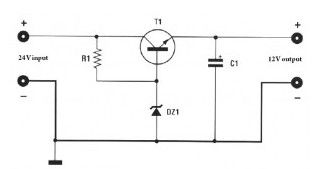
Thiscircuitisa voltagereducer24Vto12Vwithoutput current of2.5A,itcan adaptin avarious uses, it is suitableto be installedon atruckbecause ofall theelectricalcircuitsof car audio,radioandsomeother moderndevicesforcarsrequire12voltsupplyvoltage.
The use ofthis voltagereducercan also be expandedtothe CB transmission/receiver, this isdue tosupport ofcurrent2.5ampsmaximum.
(View)
View full Circuit Diagram | Comments | Reading(1026)
Battery charger indicator based LM393
Published:2013/3/18 21:00:00 Author:Ecco | Keyword: Battery charger indicator
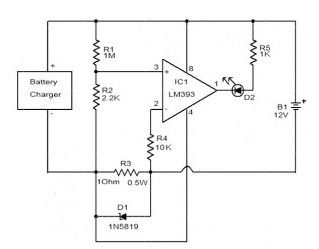
The circuit above willmakeyoursimplebatterychargerlook sophisticated. This circuit is a charging indicator forbatterycharger. Its usedtocheckwhether thebatteryis chargingornot.VoltagecomparatorLM393 ICis the heartofthis Battery charger indicator circuit.
D1LEDstays litwhenthere areat least 25milli-amps of currentwhich flowsto the battery. This circuit isdesignedspecifically for12Vbatterywith aload currentof1A.With a littlemodifying component values,load currentand voltagecan be changed.
(View)
View full Circuit Diagram | Comments | Reading(2480)
12 V Car battery charger based 7812
Published:2013/3/18 20:58:00 Author:Ecco | Keyword: 12 V , Car battery charger
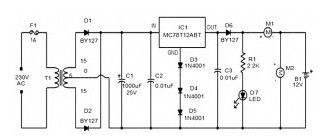
Below isa verysimplecircuitthat can be usedto charge12vcar battery. In this circuitthere isinstallationstocontrolthe charging currentand voltage. Thecircuit is based onthe circuitMC78T12ABTICfrom Freescale. ICis actually a7812with a TO-3packagewith a capacity of3A.
T1is atransformertoreducevoltageand thediodesD1andD2 performas arectifier.C1capacitoris to filterandthecapacitorC2 decoupling. The ground terminalofIC1is raisedto2.1Vusingthe diodesD3,D4andD5. Thus, theoutputofIC1is fed to14.1V(12+2.1).The battery is chargedthroughdiodeD6. D6 blocksthe flow ofreversecurrent from the batteryto the load circuit when AC poweris not available. MeterM1 showsthe charging currentand M2ofthe charge voltage.
(View)
View full Circuit Diagram | Comments | Reading(1791)
Flashing battery monitor
Published:2013/3/18 20:53:00 Author:Ecco | Keyword: Flashing battery monitor
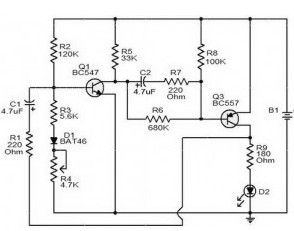
Here is asimple battery monitor circuitin which theLEDwillcontinueflashinguntil battery voltageis above thelevel. TransistorsQ1andQ2arewiredasan astable multivibratorcircuit. Thisflashingbatterymonitorcircuitcan operatefroma variety ofvoltagesfrom6Vto12V.
Thevoltagelevelat whichanLEDstopsflashingcan be setby adjustingR4. When thea presetbatteryvoltagereachesthresholdflashingfrequencydecreasesandwhenthe voltagedrops belowthe threshold ofthe diodeD1LEDturnsOFF. This is usedtocompensate for changesinvoltage ofthe baseemitterQ1due the changes intemperature.
(View)
View full Circuit Diagram | Comments | Reading(888)
Solar panel battery charger
Published:2013/3/18 20:52:00 Author:Ecco | Keyword: Solar panel, battery charger
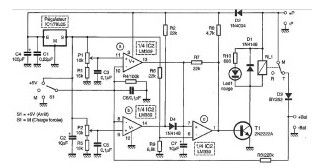
The solarbattery chargercircuit isnothing but adualcomparatorthat connects thesolar panelto the batterywhen thevoltage atthelatter terminalis lowand disconnected ifexceeding a certain threshold. Since itisonlybymeasuring thebattery voltage,it is especially intendedfor lead batteries, aelectrolyteliquid or gelled, thatadaptthebestofthisway.
The battery voltageseparatedbyR3before being fedtothe two comparatorsinIC2, When itis belowthe thresholddetermined bytheoutputofP2, IC2Bgoes highwhichalsocausesthe output ofIC2Chigh. T1saturationandrelayRL1on, allowingthe solarpaneltorechargingthe batteryvia theD3. When thebattery voltageexceedsthe threshold set byP1, When thebattery voltageexceedsthe threshold set byP1,the outputICAgoeslowas well asIC-C…and thereforecauses therelayoff,thus avoidingoverloadingwhen chargingthe battery. In orderthe thresholddeterminedby theP1andP2arestable,they aresuppliedwithan integratedregulatorIC, closelyseparatedfrom thevoltageofthe solarpanelthroughD2andC4.
(View)
View full Circuit Diagram | Comments | Reading(1017)
Car Nicd Battery charger
Published:2013/3/18 20:51:00 Author:Ecco | Keyword: Car Nicd , Battery charger
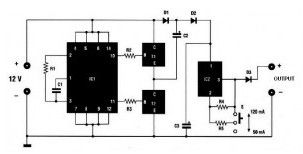
This is a car nicd battery charger circuitthat can chargeanyNi-Cdbatterybetween 4.8 and4.4 voltsfromaclassic12Voltscar battery.Thecharging currentis constantitcan beselected from the valuesof 50 to120mAbythe selectorS.
This feature is veryuseful formodel makingenthusiasts,forvideooperators,to those who usesmall appliancestransmissionandreceptionto all thosethat useNi-Cdbatteriesand needto rechargeorvoltagenetworkis not available.
(View)
View full Circuit Diagram | Comments | Reading(829)
Automatic battery charger 14-15V input with 3A max current
Published:2013/3/18 20:50:00 Author:Ecco | Keyword: Automatic battery charger, 14-15V input , 3A max current
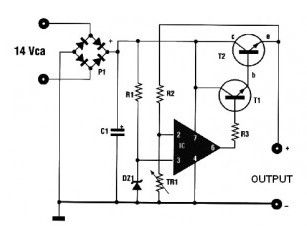
Automatic battery charger circuit is possible to realize a battery charger with excellent quality that allows it to recharge the 12 volt car battery and dry battery used in thealarm system. Operation is completely automatic, because it connects battery, battery charger will only charge the battery if it runs out, because it automatically disconnect the batteries fully charged. This device is supported by transformer with secondary voltage is 14-15 volts with a minimum of 3 Ampere current.
Theadjustmentof the trimmerTR1isawayyoudo,the outputof the battery charger, a voltage of about14.4voltswith no load.The maximum currentof3 Amperesfor distribution, it isthereforeadvisedto NOTtryto rechargebatterieswithaSuperiorcapacity 36Ah.
(View)
View full Circuit Diagram | Comments | Reading(1774)
12Vdc mobile battery charger
Published:2013/3/18 20:47:00 Author:Ecco | Keyword: 12Vdc , mobile battery charger
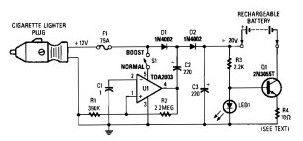
12Vdc mobile battery charger circuit diagram can delivers up to 20 V output from the 12V car power supply, allowing a constant current charging to NiCad battery unit around 18 V max.
(View)
View full Circuit Diagram | Comments | Reading(1479)
Car Battery Monitor with 3 LED
Published:2013/3/18 20:46:00 Author:Ecco | Keyword: Car Battery Monitor, 3 LED
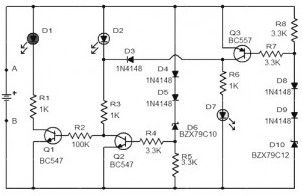
This is a circuit diagram of the 3 LED bar graph type battery monitor ideal for monitoring the voltage level of the car battery voltage with battery.
When the battery voltage is 11.5V or less transistor Q1 is turned on and the LED D1 will be bright. When the battery voltage is between 11.5 and 13.5 V, the transistor Q2 is turned on and the LED D2 will light up. When the battery voltage is 13.5V transistor Q3 will be on the D3 and the LED will light.
(View)
View full Circuit Diagram | Comments | Reading(901)
Symmetrical regulated power supply and variable 0 to 30V 2A
Published:2013/3/18 20:45:00 Author:Ecco | Keyword: Symmetrical , regulated power supply , variable 0 to 30V 2A
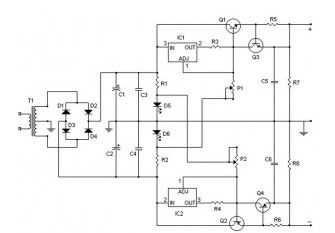
This Symmetrical regulated power supply and variable power supply 0 to 30V 2A circuit does not require further explanation, which is a controlled variable symmetric source, can deliver up to 15V per line (-15 and +15), or up to 30V as a whole, for the consumption of up to 2A, but with some changes could be modified to provide up to 5A ** (or more). Transistors Q1 and Q2 should be installed on a heat sink, as well as integrated LM337 and T LM317 which is in the TO-220 package.
(View)
View full Circuit Diagram | Comments | Reading(3048)
Lithium Ion (Li-Ion) Battery charger
Published:2013/3/18 20:44:00 Author:Ecco | Keyword: Lithium Ion , Battery charger
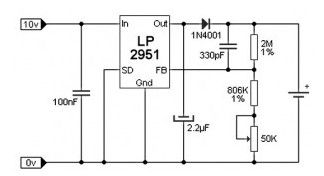
We can charge Ni-Cd or Ni-MH simply by placing a series resistor to limit current from the power source to make efficient loading. But not so with lithium ion cell (Li-Ion) which has a capacity greater than ever and don’t need to be completely discharged to charge them, but require a strictly controlled charging.
If we talk about the lithium ion cell is charged a third time against a pack of Ni-MH or one-sixth of the same cadmium. But this requires a relatively high supply current to the cell during the charging process and must be provided in the rails pulse control.
In this type of battery charging uncontrolled drip (common in alarm systems, for example) or the load resistor in series with the power lead, without exception, It will destroy itself
But there are a number of active components, semiconductors, capable of carrying the load, control and maintenance of these cells with almost no additional external components.
In the diagram we see the circuit typical Li-Ion battery charger, where it finds that it is easier to make a performance similar to discrete electronics. This chip is responsible for measuring the state of the battery (through its terminal FeedBack) and sent by the control voltage output terminal (Out). The capacitor allow to Serve as parasites RF filter and potentiometer 50 to adjust the system according to the operating voltage of the cell.
(View)
View full Circuit Diagram | Comments | Reading(961)
Converter 12 Vdc to 230 Vac or Inverter
Published:2013/3/18 4:25:00 Author:Ecco | Keyword: Converter, 12 Vdc to 230 Vac, Inverter
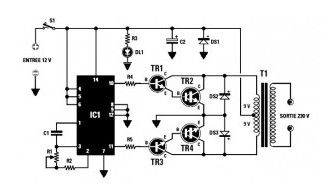
As shown in the Inverter circuit diagram obove , Its used as the oscillator stage astable multivibrator contained in IC1, a CMOS 4047 (this cult series 40xx series) by varying the resistance value of R1 trimmer (220 k total resistance) can vary the oscillation frequency of 40 Hz to 70 Hz square wave, phase shifted by 180 °, Output pin 10-11 will drives two NPN transistors TR1-TR3, which in turn is fed to the TR2-TR4.The diodes DS2-DS3, mounted on the output transistors TR2-TR4 are used to protect against voltage surges appearing across the windings V 9 + 9 V transformer T1. For the transformer T1, I used an ordinary mains transformer (primary 230 V so) with a secondary dual 2 x 9 V.
(View)
View full Circuit Diagram | Comments | Reading(2886)
15 ampere adjustable power supply
Published:2013/3/18 4:24:00 Author:Ecco | Keyword: 15 ampere , adjustable power supply
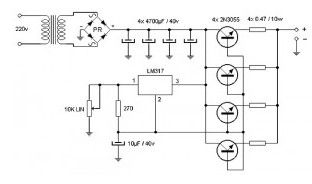
As is shown in the wiring diagram the15 A adjustable power supply provides similar amount of current through the parallel work of four power transistors, which must be mounted on a good heatsink. The voltage adjustment is performed in integrated LM317, which also must be dissipated mechanically.
The transformermust have aprimaryaccording tothe grid,while the secondaryshould provide 16voltsand 15amps.Electrolytic capacitorsshouldbe mountedparallelto join together.The bridgerectifier shouldbe at least50volts and20amps.It is recommend usingametaland mountedon theheatsink.
Outputvoltage isadjustedthrough aa linearpotentiometer. The resistorsconnected tothe emitters of thetransistors mustbe at least10watts.
(View)
View full Circuit Diagram | Comments | Reading(2437)
| Pages:145/2234 At 20141142143144145146147148149150151152153154155156157158159160Under 20 |
Circuit Categories
power supply circuit
Amplifier Circuit
Basic Circuit
LED and Light Circuit
Sensor Circuit
Signal Processing
Electrical Equipment Circuit
Control Circuit
Remote Control Circuit
A/D-D/A Converter Circuit
Audio Circuit
Measuring and Test Circuit
Communication Circuit
Computer-Related Circuit
555 Circuit
Automotive Circuit
Repairing Circuit